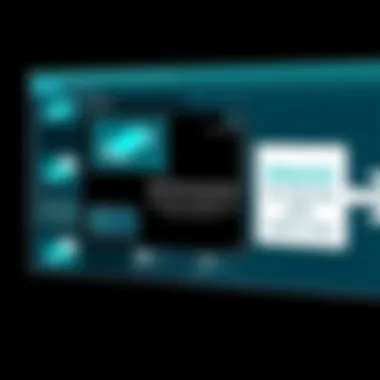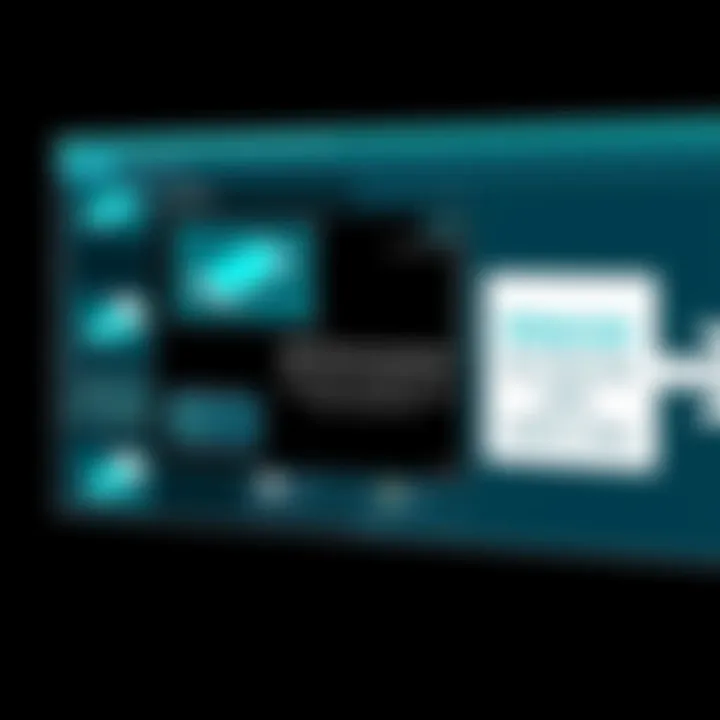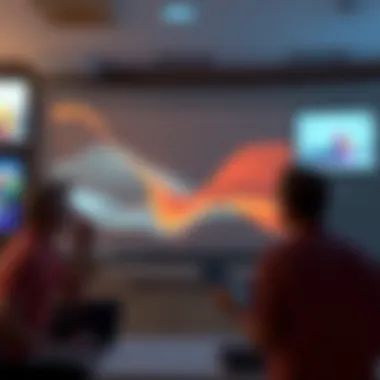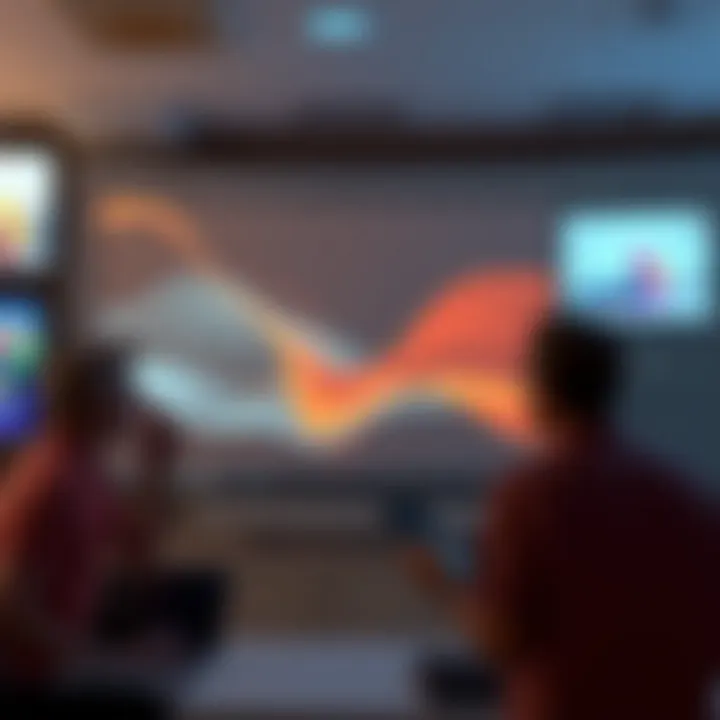Exploring Autodesk Maya: A Comprehensive Overview


Intro
As we step into the expansive world of 3D graphics and animation, Autodesk Maya stands out as a titan in the realm of digital creation. Favored by professionals across various industries, this software offers a plethora of features that facilitate the production of stunning visual effects and intricate designs. From the flickering lights of cinema to the immersive realms of video games and the intricate layouts of architectural projects, Maya plays an integral role in shaping visual narratives.
Navigating its robust interface can be daunting for newcomers, yet understanding its core functionalities unlocks a treasure trove of creative possibilities. This article endeavors to guide readers through the complex but rewarding landscape of Autodesk Maya, providing insights into its features, uses, and significance.
As we unpack the key elements—covering everything from industry trends and software comparisons to implementation strategies—you'll gain a clearer picture of how to harness Maya's capabilities effectively. This journey through the digital domain will also include a look at future trends and potential obstacles, ensuring that both novices and seasoned users find valuable takeaways.
So, let’s embark on this exploration of Autodesk Maya and embrace the artistry it enables._
Understanding Autodesk Maya
Understanding Autodesk Maya is not just about recognizing it as a software; it’s about grasping its role as a pivotal toolkit in the realm of digital creation. This section aims to peel back the layers of Autodesk Maya, exposing its intricate nature and how it serves a diverse range of industries. From film to video games and architecture, knowing Maya is key to unlocking a world of 3D graphics and animation opportunities.
Overview of Autodesk Maya
Autodesk Maya, launched in 1998, has grown to be a cornerstone in 3D modeling and animation. This software holds sway over various sectors, including entertainment, architecture, and design. With its extensive functionality, it empowers artists to bring their visions to life, making it indispensable for professionals around the globe. Users appreciate its rich feature set that supports complex tasks, transforming basic concepts into stunning visual narratives. It bridges the gap between initial ideation and final visual outputs with impressive precision.
Key Features of Autodesk Maya
Maya doesn’t cut corners when it comes to features. Here’s what sets it apart:
- Powerful Modeling Tools: The software offers an impressive range of modeling techniques, from simple polygon modeling to complex NURBS shapes.
- Animation Capabilities: Rigging, keyframe animation, and motion capture tools allow meticulous control and fluidity in character movements, creating dynamic stories.
- Rendering Solutions: The built-in Arnold Renderer delivers high-quality outputs while the viewport settings enable real-time feedback.
- Texturing Tools: Advanced texturing and UV mapping capabilities ensure every surface looks realistic and true to life.
Each of these features contributes to Maya's reputation as King of 3D software, allowing 3D artists to flex their creative muscles and explore ambitious projects, without being limited by toolsets.
User Interface and Experience
The user interface of Autodesk Maya has evolved considerably, now boasting a responsive and user-friendly layout that accommodates both novices and seasoned artists. The workspace is customizable, enabling users to tailor their environment to suit their workflow, whether they’re focusing on modeling, animation, or rendering.
- Layouts: Different layouts can be configured for specific tasks, which streamlines the process.
- Icons and Menus: Tools are efficiently organized, allowing artists to access what they need at the click of a button.
- Feedback Systems: Real-time feedback through the viewport aids instant evaluation of changes, ensuring a smooth creative process.
Despite its extensive capabilities, some newcomers may find Meyas's interface daunting. However, the initial learning curve is balanced by the long-term benefits of mastering this powerful software. Ultimately, Autodesk Maya is more than just a program; it's a gateway for creators to explore and express their artistic visions.
Historical Context and Evolution
Understanding the historical context of Autodesk Maya is crucial for grasping its significance and evolution within the realm of 3D graphics. This software has not just shaped the industry; it has also been shaped by shifts in technology and creative needs. By appreciating the trajectory of its development, users can better understand its current capabilities and its potential future. This section delves into two key areas: the milestones in its development and the impact of technological innovations that have inspired its growth.
Development Milestones
Autodesk Maya, first released in 1998, stems from the convergence of several powerful technologies and ideas. The roots can be traced back to Alias Research, who developed an early 3D modeler known as PowerAnimator. When Alias merged with Wavefront Technologies, they combined PowerAnimator’s robust features with Wavefront’s advanced rendering technology, giving birth to Maya.
Key milestones include:
- 1998: Autodesk acquired Alias|Wavefront, a significant step that ensured Maya’s integration with industry-standard workflows.
- 2002: The introduction of Maya 5, which brought features like motion capture integration, showcasing a shift towards more dynamic animation processes.
- 2005: With Maya 7, the software incorporated advancements in simulation and visual effects, accommodating the increasingly high expectations from film and gaming industries.
- 2016: This release heralded the integration of the Arnold Renderer, allowing professionals to produce photorealistic images more efficiently.
The consistent evolution over the years reflects Autodesk's commitment to addressing user needs while adapting to changing technological landscapes. Incorporating user feedback into development has been pivotal; it has allowed Maya to maintain its status as a leading application in 3D graphics.
Impact of Technological Advancements
Technological advancement remains a defining feature of Autodesk Maya’s evolution. When analyzing the software’s growth, it’s evident that external technological trends have directly influenced its capabilities.
For instance, developments in hardware performance, including the push for powerful GPUs and CPUs, have enabled more complex simulations and rendering options. The integration of artificial intelligence and machine learning technologies also paved the way for more intuitive user experiences and smarter workflows.
Furthermore, the rise of virtual reality (VR) and augmented reality (AR) has prompted Maya to tap into these new realms. Users can now create immersive environments, pushing the limits of what’s possible in animation and visualization.
To summarize, Maya's historical context reveals not only its milestones but also how its adaptability to technical advancements has solidified its place in the industry. The synergy between user demands, technological progress, and Autodesk’s innovative responses ensures a continually relevant and essential platform for 3D graphics creation.
"Maya isn't just a tool; it's a reflection of the industry’s journey, showcasing how technology has reshaped artistic expression."
For further insights into the historical context of graphics software, you may find valuable information on Wikipedia or check expert opinions on industry developments on Reddit.
With a solid understanding of its historical roots and technological progress, users can approach Autodesk Maya with a clearer sense of its capabilities and future possibilities.
Applications of Autodesk Maya
Autodesk Maya holds a prominent position in the realm of 3D graphics and animation, and its applications stretch across various industries. Understanding how this software is utilized allows professionals to harness its potential effectively. From visual storytelling in film to intricate designs in product modeling, Maya showcases its exceptional versatility. This article provides an in-depth look at the various applications of Autodesk Maya, shining a light on the specific elements, benefits, and considerations that make it indispensable in modern digital creation.
Film and Animation Industry
In the film and animation sector, Autodesk Maya is a trusted ally for artists and animators alike. It empowers users to create breathtaking visuals that captivate audiences. One specific element of Maya’s appeal lies in its robust animation tools. The keyframe animation feature allows animators to manipulate objects easily, giving life to characters in a fluid manner. Furthermore, the integration of motion capture technology adds more realism to animated performances, blending seamlessly with CG elements.
Another point to consider is Maya's adaptability. For example, in the production of animated feature films, studios like Pixar have leveraged Maya’s advanced modeling capabilities to create complex environments and characters. This has not only made production more efficient but has also enhanced storytelling potency by providing an expansive canvas upon which creators can illustrate intricate tales. Whether it's crafting a whimsical unicorn or a lifelike dragon, Maya proves to be a vital tool in effectively communicating narratives through animation.
"Maya allows artists to explore new creative frontiers, pushing the limits of traditional storytelling into uncharted territories."


Video Game Development
Transitioning into video game development, Autodesk Maya's significance is equally pronounced. Game designers often rely on it to opt for efficient modeling and animation processes. Inside Maya, the Polygon Modeling method is often favored, enabling designers to craft detailed character models that can be easily manipulated.
Moreover, Maya's support for rigging is a game-changer. By providing comprehensive rigging capabilities, developers can create characters that move realistically within game environments. For instance, companies like Electronic Arts have integrated Maya into their production pipelines to streamline workflows, thereby speeding up the time to market of new games. Optimizing performance while maintaining detailed visuals becomes a harmonious balance through the functionalities offered by Maya.
Architectural Visualization
In the world of architecture, Autodesk Maya plays a pivotal role in visualizing designs before they are built. Through its powerful rendering tools, architects can present both interior and exterior visualizations that closely resemble the final product. Maya’s UV Mapping and Shading Networks allow for the realistic depiction of materials, making it easier for clients to understand the architect’s vision.
Additionally, the software permits collaboration between architects and designers. For instance, Maya’s integration with applications like Autodesk Revit facilitates seamless transitions between the planning and visualization stages. This ensures that the designs not only look good but also adhere to practical considerations, thus bridging the gap between artistic vision and engineering precision.
Product Design and Modeling
Lastly, in the field of product design, Autodesk Maya is leveraged to create detailed models that reflect the intended functionality and aesthetic appeal of new products. Designers utilize Maya's Subdivision Surfaces functionality to yield high-quality surfaces that exhibit precision. This is crucial for industries such as consumer electronics, where the visual aspects of a product can significantly influence consumer appeal.
Maya’s capability to produce photorealistic renders allows designers to present their concepts to stakeholders effectively. This ability facilitates discussions around design elements, enabling a streamlined feedback process. Companies can iterate on designs faster, ultimately enhancing their market responsiveness.
Core Functionalities of Autodesk Maya
Understanding the core functionalities of Autodesk Maya is akin to peeking behind the curtain of a complex yet brilliantly crafted performance. These key elements drive the software's capability to create stunning 3D graphics, making it a staple in various industries. From modeling to rendering, these functionalities not only enhance the user’s experience but also reinforce Maya's position as a leader in the 3D animation landscape.
Modeling Techniques
Creating the very buildings blocks of a 3D model often starts with various modeling techniques. Maya gives users a flexible toolkit to shape and refine their visions uniquely.
Polygon Modeling
Polygon Modeling is the bread and butter for many digital artists. This method involves creating objects using polygonal shapes that can represent both simple and intricate designs. The key characteristic of polygon modeling is its versatility. Artists can manipulate vertices, edges, and faces to create detailed structures, thus allowing for high customizability. One of the unique benefits of this technique is its suitability for creating more complex forms. However, while polygons can enable intricate designs, they may also lead to a complicated mesh, potentially posing challenges during the texturing phase.
NURBS Modeling
Next up is NURBS modeling, which stands for Non-Uniform Rational B-Splines. This technique is favored for its precision and smooth surfaces. The key characteristic of NURBS is its mathematical approach, enabling artists to create curves and surfaces that are highly accurate. This makes it a popular choice in industries like automotive design, where precision is non-negotiable. The unique feature of NURBS modeling lies in its ability to represent any shape with remarkable accuracy. Despite its advantages, mastering NURBS can be a challenge for newcomers, mostly due to the complexity of its controls and manipulation techniques.
Subdivision Surfaces
Subdivision Surfacing is a technique that allows for creating smooth and high-resolution surfaces from coarse meshes. The key characteristic here is the process of subdividing polygonal meshes to achieve finer detail. This method is particularly beneficial in creating character models in animation, where a high quality, organic look is critical. The unique feature of subdivision surfaces is that they can maintain the original polygon shape while providing the smoothness akin to NURBS. One disadvantage, however, is that it can demand heavy computational resources, making it essential to have a capable machine during the detailing phase.
Animation Tools
Animation is the soul of digital storytelling, and Maya provides a robust suite of tools for animators. These tools help bring characters and scenes to life, showcasing the artistry of the creator.
Keyframe Animation
Keyframe Animation is a fundamental concept in animating objects or characters over time. This method uses specific frames—keyframes—to define start and end points for movement. The key characteristic of keyframe animation is its straightforward, intuitive process. It's particularly beneficial because it allows for precise control over transition speeds and effects. A unique aspect of this technique is that it can efficiently handle both complex and simple animations with ease. That said, achieving perfect timing can sometimes require a bit of trial and error, making the initial learning curve somewhat steep.
Motion Capture
Motion Capture (often abbreviated to MoCap) involves capturing real-life movement and translating it into a digital format for animation. This key characteristic offers animators a way to create incredibly realistic animations by using actual human movements. This technology can significantly boost production value, making it a sought-after choice in both films and video games. A unique feature of this technique is its ability to capture nuanced actions and expressions, reflecting them accurately onto digital characters. However, it requires significant hardware and software investments, which may deter smaller studios or independent creators.
Rigging
Rigging is the process of creating a skeletal structure for 3D models, allowing for easy movement and animation. The key characteristic of rigging is its necessity in character animation, enabling artists to give life to their creations. It's a popular choice because it streamlines the animation process, allowing for complex movements without reworking the entire model. One unique feature is the ability to create control rigs, which simplify the animator's task by providing intuitive controls. A potential downside is that a poorly designed rig can lead to animation complications later down the line.
Rendering Capabilities
Rendering is the final step that brings everything together, turning 3D models into lifelike images or animations. Maya supports various rendering techniques that cater to different needs.
Arnold Renderer
Arnold Renderer is a powerful ray-tracing engine that excels in delivering photorealistic imagery. Its key characteristic is the ability to handle complex lighting and shading scenarios. This makes it a very beneficial option for projects that require a high level of realism, such as visual effects in film. Arnold’s unique feature is its strong integration with Maya, allowing for a seamless workflow. However, its high-quality rendering can also lead to longer render times, a trade-off that many artists must consider.
Viewport 2.
Viewport 2.0 is an advanced rendering engine that allows real-time visualization of scenes within Maya. The key characteristic of this tool is its capability to render scenes quickly, giving artists immediate feedback as they work. It’s particularly helpful during the modeling and animation processes where adjustments may happen frequently. The unique aspect of Viewport 2.0 is its support for high-quality texture, effects, and lighting, enabling artists to achieve a near-finished look without exporting. A downside to be aware of is that the visual fidelity may not match the final render when using other high-end renderers.
Texturing and Shading
The process of texturing and shading is crucial in giving depth and dimension to 3D objects, influencing how they interact with light and environment.
UV Mapping
UV Mapping is the process of projecting a 2D image texture onto a 3D model’s surface. This technique’s key characteristic is its critical role in determining how textures are applied and which parts of a model will show specific details. It's a beneficial choice for artists since proper UV mapping can make textures appear seamless and lifelike. One unique feature is the ability to create complex, high-resolution textures that can enhance a model's detail significantly. However, intricate UV layouts can become complex, making it a challenge for those new to the process.
Shading Networks
Shading Networks allow artists to create custom shading setups for their models. This aspect provides tremendous flexibility, giving the artists command over how surfaces interact with light. The key characteristic of shading networks is their ability to layer multiple materials and effects, presenting a realistic finish. They are popular among experienced users for creating intricate looks, but they come with a learning curve that can be daunting for beginners. One downside is the time investment required to understand and effectively use these networks, which can hinder productivity in fast-paced projects.


"Understanding and mastering these core functionalities of Autodesk Maya can dramatically expand the limits of what digital artists can achieve, fostering creativity and innovation in their work."
In summary, the power of Autodesk Maya lies in its core functionalities, which streamline the artistic process while allowing for complex and nuanced creativity. As you dive into these elements, you'll find that they not only make the software effective but essential in the world of 3D graphics.
Plugins and Extensions
In the ever-evolving landscape of 3D graphics, plugins and extensions play a pivotal role in enhancing the capabilities of Autodesk Maya. These tools can dramatically streamline workflows, improve rendering times, and expand the software's functionality far beyond its standard features. For professionals and hobbyists alike, leveraging third-party plugins can be the difference between a mediocre project and a dazzling masterpiece. The importance of these tools lies not just in their individual capabilities, but in how they seamlessly integrate into an existing ecosystem, allowing users to tailor their experience according to specific project requirements.
One should consider several aspects when choosing plugins and extensions, including compatibility, ease of use, and the specific advantages they offer in enhancing Maya's core functionalities. Understanding how these tools can enhance workflows helps artists to remain competitive and efficient amidst the ever-growing demands of the industry.
Popular Third-Party Plugins
V-Ray
V-Ray, a highly regarded rendering engine, is well-known for its ability to produce photorealistic images with extraordinary speed. The specific aspect of V-Ray that stands out is its versatility, allowing it to operate seamlessly across various platforms, including not only Autodesk Maya but also other notable applications like 3ds Max and SketchUp. This flexibility makes V-Ray a popular choice among users aiming for top-quality outputs without sacrificing efficiency.
One key characteristic of V-Ray is its robust lighting and shading capabilities, which significantly aid in achieving lifelike results. Users appreciate this because it reduces the learning curve associated with creating complex materials and lighting setups. A unique feature of V-Ray is its Progressive Rendering, which enables users to see changes in real time without having to wait for a complete render, leading to faster feedback cycles during the creative process. However, V-Ray does require a powerful machine to run efficiently, which might pose a challenge for those with limited hardware resources, something potential users should keep in mind.
Octane Render
Octane Render is renowned for its speed and efficiency, utilizing a GPU-based rendering process that accelerates results significantly compared to CPU-based counterparts. This particular aspect has placed Octane at the forefront of the industry, as the demand for quicker turnaround times becomes more prevalent. What's often cited as a major advantage is its ability to deliver stunning, high-quality visuals with comparatively lower resource consumption.
The standout characteristic of Octane Render is its real-time rendering capabilities. Artists can make adjustments to lighting and materials and see the consequences instantly, facilitating a more interactive and iterative workflow. However, while Octane excels in providing fast rendering, the reliance on GPU means that users need adequate graphics hardware, which might not be affordable for everyone. For those who do have the right setup, Octane can be a game changer in terms of efficiency and output quality.
RealFlow
RealFlow is specialized in fluid simulations, adding yet another layer of complexity and realism to animations created in Maya. This specific aspect of RealFlow appeals to artists keen on creating water, smoke, and other fluid dynamics without the constraints often found in native tools. The key characteristic that keeps RealFlow in the conversation among professionals is its powerful simulation system, which is praised for its depth and detail.
Segregating its unique feature, RealFlow allows for interaction between fluids and rigid bodies, giving creators unmatched flexibility in animating intricate scenes. However, the learning curve can be steep. Users might find themselves investing considerable time to master the nuances of its simulation interface, but for those willing to persevere, the results can be exceptionally rewarding, as it can elevate their work significantly.
Custom Scripts for Enhanced Workflows
In addition to utilizing popular plugins, customizing workflows through scripting is another avenue for enhancing productivity in Autodesk Maya. Custom scripts can automate repetitive tasks, streamline complex processes, and offer tailored solutions that third-party plugins might not provide. This form of optimization enables artists and developers to creatively approach their challenges and enhances overall efficiency, making the most of the powerful features that Maya offers. Crafting simple scripts not only empowers users to personalize their experience but also fosters a deeper understanding of the software's capabilities, which is crucial in a competitive field.
Learning and Community Resources
In the fast-evolving landscape of 3D graphics, staying abreast of new trends and techniques is vital for success. This part is essential as it provides insight into how users can access valuable resources to master Autodesk Maya, ranging from structured learning paths to peer support. With a combination of official resources, online courses, and vibrant community forums, users at every level can find ample opportunities for growth.
Official Autodesk Learning Resources
Autodesk itself offers a treasure trove of resources tailored to help users dive deep into their powerful software. The Autodesk Knowledge Network is a prime hub where users can explore tutorials, articles, and detailed product documentation. Accessing this resource is akin to having a personal tutor who guides you through the various functionalities of Maya. Users benefit from regularly updated content that reflects the latest software versions and techniques.
For a more structured approach, Autodesk provides guided learning paths. These paths cater to various skill levels, ensuring that even beginners can progress steadily without feeling overwhelmed. By following these carefully crafted modules, learners can gain a solid foundation and build upon it, ultimately leading them to achieve intricate designs and animations.
Online Courses and Tutorials
With the rise of e-learning, numerous platforms have arisen to offer courses specifically focused on Autodesk Maya. Websites like Udemy, Coursera, and LinkedIn Learning present courses that range from introductory lessons to advanced 3D modeling techniques. One can find instructors who are industry professionals sharing their expertise, which can be invaluable.
- Advantages of Online Learning:
- Flexibility: Students can learn at their own pace, fitting their studies around their schedules.
- Diverse Topics: From character animation to rigging and simulation, there's nearly a course for every interest.
- Budget-Friendly Options: Many courses are accessible at a low cost or even free, making quality education attainable.
These materials often include project-based assignments that allow learners to apply what they've studied, fostering a practical understanding of the software.
Forums and Support Communities
Typically, the best learning doesn't come from a textbook but rather from engaging with a community of passionate users. Forums such as Reddit, particularly the r/Maya subreddit, are bustling with activity where users share tips, critiques, and project feedback. Here, a novice can ask about the best modeling techniques while seasoned pros can post their latest creations to receive constructive insight.
Benefits of Community Engagement:
- Networking Opportunities: Meet fellow artists, potential collaborators, or mentors.
- Real-Time Problem Solving: Encountered a snag in your project? Chances are someone has faced the same issue and can help you troubleshoot.
- Inspiration and Motivation: Engaging with others can spark creativity and keep your creative juices flowing.
"The best teachers are those who show you where to look, but don’t tell you what to see."
This quote aptly summarizes the learning journey within communities where the emphasis is placed on exploration and discovery.
Comparative Analysis with Other Software
Understanding how Autodesk Maya stacks up against its competitors is crucial for decision-makers and professionals in 3D graphics. The landscape of 3D software is vast, and each program offers unique features and capabilities that cater to different needs within the industry. In this section, we will explore a side-by-side comparison of Maya with three prominent alternatives: Blender, Cinema 4D, and 3ds Max. This will provide insight into the strengths and weaknesses of each software, helping users make an informed decision based on their requirements.
Maya vs. Blender
Blender is an increasingly popular open-source software that has gained traction in recent years, especially among indie developers and small studios. Right off the bat, a significant difference is cost; Blender is free, whereas Maya typically requires a subscription or licensing fee.
Here are some critical considerations in the comparison of Maya and Blender:
- User Interface: Maya's interface, while powerful, can feel overwhelming to newcomers. Blender has made strides in simplifying its UI, making it more approachable for beginners.
- Rendering: Maya, utilizing Arnold Renderer, has robust lighting and shadow features, excelling in producing high-quality visuals. Blender, with its Eevee and Cycles render engines, is versatile but might require some tweaking for complex scenes.
- Community and Resources: Blender has a vibrant community driven by resource sharing and tutorials available for free. Maya’s community is also helpful, but more resources often come at a price, reflecting its commercial nature.
Overall, if budget is a constraint and one seeks a comprehensive tool for general 3D work, Blender can be a formidable competitor. However, for large-scale productions and more sophisticated features, Maya’s depth remains the go-to.


Maya vs. Cinema 4D
Cinema 4D, known for its motion graphics capabilities, serves a different audience compared to Maya. While both programs handle modeling, animation, and rendering, their applications can diverge significantly.
Key comparisons include:
- Ease of Use: Often praised for its user-friendly interface, Cinema 4D can provide quicker results, making it ideal for motion graphics artists. Maya, on the other hand, typically has a steeper learning curve, making it more suited for detailed animations and character rigging.
- Animation Features: Maya shines with its animation tools, allowing for complex character animations through rigging and keyframes. Conversely, Cinema 4D offers excellent tools for creating dynamic animations with minimal effort.
- Integration: Cinema 4D integrates exceptionally well with Adobe products, which is a significant plus for those already in the Adobe ecosystem; Maya can integrate too, but it might require additional steps.
If your focus is on motion graphics, Cinema 4D could be the more efficient choice, whereas Maya excels in character animation and detailed project work.
Maya vs. 3ds Max
3ds Max has long been regarded as a staple in game development and architectural visualization. Both Autodesk products share a lot in common, yet they cater to different niches within the 3D graphics space.
The distinguishing features include:
- Modeling Capabilities: While both programs use polygon and NURBS modeling, 3ds Max is often viewed as having a more intuitive modeling workflow, which appeals to architects and industrial designers.
- Animation Tools: Maya is widely recognized in the animation realm due to its sophisticated rigging and complex animation capabilities, whereas 3ds Max tends to be favored for its efficient working pipeline suited for games.
- Rendering and Visualization: 3ds Max offers V-Ray support and straightforward rendering processes, which is often beneficial for quick visualizations in architecture. Maya’s rendering capabilities are powerful but may require more time investment to achieve similar results.
In summary, for architectural visualization or straightforward modeling tasks, 3ds Max proves its worth. Yet for character animation and more complex production pipelines, Maya remains unmatched.
"Choosing the right software can be as critical as selecting the right tools for a craftsman. Each has its strengths; knowing what you need can guide you in the right direction."
This comparative analysis helps illustrate that while Maya is a robust tool for professionals in multiple industries, evaluating its capabilities against alternatives like Blender, Cinema 4D, and 3ds Max can reveal the best fit for specific needs. Whether it's budget, type of work, or workflow that matters most, understanding these nuances can lead to a more effective 3D creation experience.
Challenges and Limitations
When it comes to Autodesk Maya, looking beyond its remarkable capabilities is equally essential. The challenges and limitations provide insight not just into the software’s current state but also its potential hurdles for users. In the entire landscape of 3D graphics creation, understanding what might hold certain users back is critical for decision-makers and professionals alike. Several key areas illustrate these challenges from system performance to usability concerns.
System Requirements and Performance
One of the primary challenges faced by Autodesk Maya users is its demanding system requirements. In order to fully leverage Maya's extensive features, a powerful setup is crucial. A decent GPU, ample RAM, and a robust processor become non-negotiables for smooth functionality. For instance, while the minimum requirement may allow users to run the software, operating at anything close to it can lead to a sluggish experience, particularly in complex scenes where rendering speeds can drag to a crawl. It's wise to consider the following:
- CPU: A multi-core CPU significantly boosts rendering times, especially for detailed projects.
- RAM: Generally, it’s recommended to have at least 16 GB of RAM, while 32 GB or more can provide a much smoother experience.
- Graphics Card: Compatibility with NVIDIA or AMD cards that support OpenGL helps optimize viewport performance.
It’s not just about having the right hardware though. Keeping everything updated, including the operating system and graphic drivers, prevents frustrating hiccups during crucial project timelines. Choosing to invest in a solid workstation is not merely a suggestion but rather a necessity for those serious about using Maya without interruptions.
"A craftsman is only as good as their tools" — this adage resonates deeply within the realm of 3D modeling.
Learning Curve and Usability Concerns
AutoDesk Maya is rich with features, and while that’s a phenomenal boon for graphic artists and animators, it brings along a steep learning curve. For a novice, the initial foray into Maya can feel akin to diving into the deep end of the pool without knowing how to swim. The user interface, though designed with potential workflows in mind, can be overwhelming for someone just starting out.
Consider the following aspects:
- Complexity of Features: With tools for modeling, rigging, animation, and simulation, newcomers might feel lost amidst it all. For example, grasping rigging properly might take significantly longer than anticipated, which can lead to frustration and potentially hinder the creative process.
- Resources to Learn: While there are a plethora of tutorials available, sorting through countless options to find ones that truly resonate can feel like finding a needle in a haystack.
- Time Investment: Users must be prepared to dedicate significant time not only to learn but to become proficient. A simple task might require extensive adjustments and tweaks to reach a satisfactory outcome, prolonging project timelines.
Undoubtedly, Maya holds tremendous potential and remains a leading tool in the industry. However, overcoming its challenges requires commitment and resources, making it crucial for decision-makers to weigh these considerations carefully against project timelines and budget allocations.
Future Trends in 3D Graphics Software
As we navigate the ever-changing waters of digital content creation, it’s clear that 3D graphics software is on the cusp of significant evolution. Autodesk Maya stands at the heart of these transformations, acting as both a powerful tool and a reflection of broader trends shaping the industry. Understanding the future trends in 3D graphics is essential for decision-makers and IT professionals who aim to stay ahead of the curve.
Technological Innovations
The relentless march of technology provides fertile ground for innovations in 3D graphics software. One area gaining traction is real-time rendering. This technology enables artists to visualize their work with remarkable immediacy, which simply wasn’t feasible before. With strides in GPU capabilities and software optimization, artists can tweak scenes and see adjustments in real-time, creating smoother workflows and more dynamic outputs.
Additionally, advancements in virtual reality (VR) and augmented reality (AR) are significantly influencing how 3D content is developed. This shift offers a new realm of interactivity, allowing users to experience environments as if they were physically present within them. This trend is influencing industries from gaming to architecture, and its repercussions resonate deeply within Autodesk Maya. As the software adapts to accommodate VR and AR needs, users can create more immersive content, paving the way for new storytelling techniques.
Another noteworthy trend is the integration of machine learning and AI algorithms into 3D modeling. These technologies can automate repetitive tasks, analyze existing designs, and assist artists in making creative decisions. For instance, AI can help in generating variations of a model, significantly reducing the time spent on iterations. It’s a game-changer that promises to redefine workflows and unleash the creative potential of artists.
Industry Adoption and Forecast
As we peer into the crystal ball, it’s apparent that industry adoption of advanced 3D graphics tools is on the rise, with Autodesk Maya leading the charge. Growing demand in sectors like film, video games, and virtual experiences ensures that software capable of exponentially enhancing production quality will see sustained interest.
"The 3D graphics software market is poised for growth at a rapid pace, with an estimated valuation touching over $4 billion by 2025."
Moreover, as industries increasingly pivot to remote collaboration, tools that facilitate seamless teamwork are paramount. Autodesk Maya continues to evolve to meet these needs by enhancing cloud functionalities, allowing users around the globe to connect and work together regardless of their physical locations. This capability is especially vital in industries where multi-disciplinary teams need to collaborate on complex projects.
The End
In wrapping things up, Autodesk Maya stands as a beacon in the world of 3D graphics and animation, playing a vital role across multiple industries. Its deep-rooted functionalities not only cater to professionals but also aspiring artists wanting to leave their mark in the visual medium.
Summarizing the Importance of Autodesk Maya
When we look back through this discussion, it’s clear that Maya's significance cannot be overstated. Its versatility is one of its strongest suits; it is a bridge connecting various fields from film production to product development. The demanding nature of these industries requires tools that can keep pace with evolving standards, and Autodesk Maya rises to the occasion.
- Key Features: Its comprehensive modeling, rendering, and animation capabilities provide artists the means to express their creativity without bounds. The software's feature set, like keyframe animation and equipped rendering options, are indispensable for crafting compelling visual narratives.
- Industry Adoption: The way big players in film, gaming, and architecture leverage Maya speaks volumes about its reliability. Through the years, it has been the backbone for many landmark projects, allowing artists to bring their imaginative realms to life.
- Continuous Evolution: A big plus for Autodesk Maya is how it adapts to technological advancements, integrating new techniques while maintaining a user-friendly interface that appeals to both novices and seasoned professionals. Thus, investing time in learning this software can prove to be invaluable for career growth.
Whether you are just dipping your toes into 3D animation or are on the fast track to becoming a seasoned designer, understanding Autodesk Maya positions you rightly within the tech landscape. Having this software in your toolkit equips you to tackle challenges more creatively. So, as we draw this exploration to a close, remember that Maya is not just a tool, it's a springboard for your imagination, shaping the future of digital media.
"Tools make the trade; incorporate Maya, and watch your creative possibilities soar."
To stay updated on the latest insights, consider joining communities like reddit.com where discussions on best practices and tips run rampant, keeping your skills sharp and your knowledge fresh as you navigate this digital artistry realm.



